 |
 |
 |
| Historical Profile of Capurso |
 |
|
- Origins
- Town Growth
- Middle Ages
- Historical Structures
- King of Time
- Feudal Property
- Road Network
- Communities Outside the Walls
- Madonna of the Well Sanctuary
- Cemeteries
- Town Life and Public Services
- Railroad and Contemporary Expansion
- Emigration ed Immigration
- References
|
|
 |
|
 Origins
Origins |
|
 |
|
|
The origin of Capurso probably goes back to the year 888, when Bari was
a possession of Anjon, prince of Benevento. The origin of the name
is uncertain. Some attribute it to the Latin term "locus caprutium," goat
pasture, from which came Caprusium, and hence Capursium, the Latin
name of Capurso. |
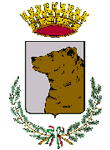 |
 |
|
A popular legend instead attributes the name to some hunters who
buried the head of a bear they had killed under an oak tree where
the town of Capurso later rose. The Latin version of head of a bear
is "caput ursi", wherefrom Capursium is thought to come from. The coat of arms
for the town draws from this story showing the head of a bear. |
| |
 |
|


 |
|
 |
|
 Town Growth
Town Growth |
|
 |
|
|
Capurso started out very small, some houses and farms, and grew slowly.
The major influxes of people came when people living on the
seacoast sought refuge in the hinterland, where Capurso was located
among other towns, following
the excursions of pirates and Saracens that plundered the Mediterranean coasts
in that period. Capurso was a well established center in the eleventh
century as mentioned in many historical documents that refer to Capurso
at that time. The population grew to about a thousand people
by the 1500 and to approximately 5,000 people by the beginning
of the twentieth century. Capurso counted about 7,000 people after
World War II, and has double that number (14,000) in recent decades
due to an influx of new people from Bari, nearby. |
 |
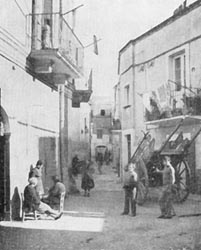 Pizzoli Street, in the old section.
Pizzoli Street, in the old section. |
| |
 |
|


 |
|
 |
|
 Middle Ages
Middle Ages |
|
 |
|
|
During the Middle Ages, the portion Capurso that nowadays
is referred to as the ancient section was enclosed by walls.
The walls, with an external ditch,
formed a continuous circle around the ancient town with only two doors:
the public square door on the east side of town, and the the lake door
on the west side, so called because the adjacent open area would flood
readily when it rained.
The walls were assimilated into private constructions in later centuries
and have nearly disappeared. Remains are still visible at some locations
as part of newer constructions.
The two doors were torn down respectively in 1813 and 1868.
Other crossings were opened later in the walls to provide easier
accesses to the ancient section. |
 |
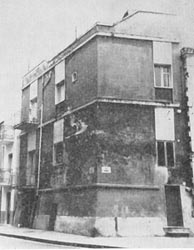 Portions of the ancient walls.
Portions of the ancient walls. |
| |
 |
|


 |
|
 |
|
 Historical Structures
Historical Structures |
|
 |
|
|
The ancient town had a castle that has since disappeared, two communal ovens,
a public square, the Church of St. Anthony the Abbot (initially the master church),
and tree other small churches that attest to the religious character of
the life and appearance of the ancient town. The small Church of the Purgatory,
that today has been rededicated to the Madonna of the
Carmine, was constructed in 1666. The little Church of St. Anthony of Padua
was constructed on the old town wall. |
 |
 Madonna del Carmine Church.
Madonna del Carmine Church. |
| |
 |
|


 |
|
 |
|
 King of Time
King of Time |
|
 |
|
|
The Church of St. Salvatore was built in 1535 by Queen Bona
Sforza, and was later rededicated to St. Bernardino, now the master
church for the town.
The town wall nearby was demolished in 1818 in order to construct
the sacristy for the church and other premises.
The public clock and the King of Time were built
in 1825, quickly becoming popular icons for the town of Capurso.
The statue of a bearded king dominated from the turret
pointing with one hand to the clock and the
passing of time, hence King of Time.
The clock had two bells that rang the passing of the hours.
The unexpected collapse of the sacristy on March 21, 1975, destroyed
the clock and the King of Time.
The sacristy was rebuilt, but the clock and the King
of Time were not and have faded into history. |
 |
 King of Time.
King of Time. |
| |
 |
|


 |
|
 |
|
 Feudal Property
Feudal Property |
|
 |
|
|
In the Middle Ages the town passed on as property from a lord
to another; they had absolute civil and penal powers on the people
that they governed for the monarchs. Several families
were noteworthy. The period of Queen Bona Sforza was probably the
most prolific and benevolent for the town.
Queen Bona was born from Gian Galeazzo Sforza, duke of Milan, and Isabella
of Aragon, daughter of king Alfonso, and married to Sigmund,
king of Poland, in 1517. Capurso was one of the Queen's
possession and her rule produced several works, among which is
the master church. The history of Capurso continued like this until
napoleonic times when servitude ended. |
 |
 Master Church.
Master Church. |
| |
 |
|


 |
|
 |
|
 Road Network
Road Network |
|
 |
|
In ancient times, Capurso was connected with Cellamare, Noicattaro,
Triggiano, Carbonara, and Valenzano.
Traveling to Bari required going through Triggiano,
and for Casamassima one had to travel through Cellamare.
The Ognissanti road appears to have been a branch of the
ancient Appian road constructed
by the Roman that through Egnazia reached Brindisi.
The construction of the Consolare road allowed Capurso to be connected
directly to Bari on one side and to Casamassima on the other side.
Noicattaro road was built in 1829, while the rectilinear road to Valenzano
was constructed in 1845. |
|
 |
|


 |
|
 |
|
 Communities Outside the Walls
Communities Outside the Walls |
|
 |
|
|
As the town expanded, other communities and neighborhoods settled
just outside of the ancient town walls. These
neighborhoods are known as follows:
Mastracina, Piscino, St. Barbara (going towards Carbonara), Grottemorgola,
and Ognissanti (going towards Valenzano). Other churches were built
outside of the ancient section; they include: the Church of
St. Mary Ara Coeli, where now rises the Church of St. Francis;
the Church of the Madonna delle Grazie,
built in 1606 at the
fork of the roads that led respectively to Noicattaro and Cellamare;
the Church of St. Carlo built in 1698; the small Church of St. Lorenzo
built on the road towards Noicattaro in 1705; and the small Church of St. Gaetano
built on the the hill of Pacifico. Noteworthy was also the "neviera,"
built on the road to Noicattaro; it was a magazine where snow was
stored in winter and then sold to the public in summer. |
 |
 Madonna delle Grazie Church.
Madonna delle Grazie Church.
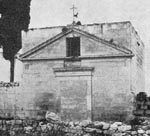 St. Gaetano Church.
St. Gaetano Church.
|
| |
 |
|


 |
|
 |
|
 Madonna of the Well Sanctuary
Madonna of the Well Sanctuary |
|
 |
|
|
According to folklore, the priest Domenico Tanzella in 1705,
being very sick and near death, had a vision of the Madonna
instructing him to drink water from a nearby ground well.
This ground well was located on the road to Noicattaro,
and the priest recovered completely after he had drunk water taken
from that well.
Afterwards, the priest and two other people descended into
the well to find out about this miraculous water and discovered
an image of the Madonna on the wall at the bottom of the well.
This image separated miraculously from the wall and the priest
had it placed in a chapel that was built nearby.
The picture, clearly of Byzantine origins, probably goes back
to the times of the iconoclasic fury of the Byzantine Emperor
"Leone Isaurico" that forced "basiliani" monks to escape
back to the Italian coasts.
The discovery
of the image spread troughout the region, then the realm, creating
a cult for the Madonna of the Well
that culminated in the nineteenth century and continues to these days. |
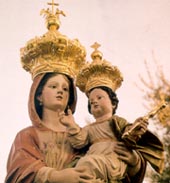 Madonna of the Well.
Madonna of the Well.
 Sanctuary from old picture.
Sanctuary from old picture.
 Inside the well.
Inside the well.
|
 |
|
The cult and care of the Madonna of the Well fell initially to the
order of the Alcantarini friars. They first built a convent in 1750, with
the donations and offerings received from the faithfuls and pilgrims. Later
the friars built a great church where now resides the image recovered
from the well; the church was completed in 1770.
The cult of the Madonna of the Well made the town of Capurso well known
throughout the realm, attracting nobility and ecclesiasts from all
over Italy and later the world.
The church was designated a minor basilica by Pope Pius IX in 1853;
the well itself where the image had been found, since
fallen in a state of abandonment, was restored and provided with
a chapel and a stairwell that leads pilgrims to the bottom of the well.
The chaotic events that led to the political unification of Italy in
1861 and the following decades were tempestuous years
that saw the convent of the Alcantarini friars pass to civilian
control first, then to the control of priests under civilian administration,
and finally to the control of the "Minori" Friars,
successors to the Alcantarini friar order, at the beginning of the
1900s. The new century brought more discord; the Franciscan friars
took final control of the convent in 1967. |
| |
 |
|


 |
|
 |
|
 Cemeteries
Cemeteries |
|
 |
|
Capurso has an old cemetery on the road to Carbonara that was opened in 1850.
A newer cemetery, bigger and modern, was opened in 1903.
| |
 |
|


 |
|
 |
|
 Town Life and Public Services
Town Life and Public Services |
|
 |
|
|
Life for the people of Capurso was poor under the feudal system and
during the Bourbonic reign. Few people knew how to read and write;
elementary schools were opened in 1862. The standard of living
during the 1800s remained poor and frugal; the main economic activity was
agriculture and there was almost no commerce.
The water came from wells and underground reservoirs. Beyond
providing water, city hall provided for the distribution in summer
of snow stored during winter in the "neviera."
Public lighting was nonexistent; the town at night was
completely in the dark. Homes were illuminated by kitchen-oil lamps,
candles, and some kerosene lamps. Roads were
deserted at dusk and there were no taverns, bars, or other public
meeting places. Capurso acquired used kerosene lamps from the city
of Bari in 1869, in order to provide some street lighting.
In 1902, street light illumination was modernized to utilize
acetylene gas. A project for electrical street lighting was first
proposed in 1913 and was finally realized in 1923. |
 |
 Farmer with horse drawn hoe.
Farmer with horse drawn hoe.
|
| |
 |
|


 |
|
 |
|
 Railroad and Contemporary Expansion
Railroad and Contemporary Expansion |
|
 |
|
|
The "Ferrovia Sud-Est" (Sud-Est Railroad Company) proposed to establish a line
that connected Bari to Locorondo in 1883, passing through Capurso;
work began in 1890.
A road was built in Capurso in 1907 connecting the railway station,
at the periphery of town, to the main
public square. The Villa Comunale (a town park) was
constructed in the opening in front of the Madonna of the Well in 1903.
A memorial to the fallen soldiers during the World War of 1915-18 was added
to the park in 1924. A bypass road was conceived in 1903 to reroute
traffic from the center of town and relieve congestion; the plan
was subjected to many modifications and negotiations and was finally
realized in 1929 as a link between the park and the road to Casamassima.
The "Aqueddotto Pugliese" (a government entity organized for a
project to provide water to Puglia in the early 1900s) revolutionized
life for the whole Puglia region, including Capurso. Public fountains
were constructed where people could fill up jars, bottles, and buckets with water. |
 Public fountain.
Public fountain.
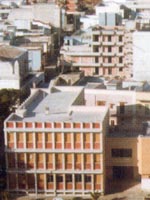 Contemporary buildings.
Contemporary buildings. |
 |
|
Development plans were prepared in 1972 for the constructions of new
housing, bringing in a remarkable and programmed expansion of the town.
There was a large influx of
new residents, mostly from Bari, the much larger city nearby
seat of local government for the region. Contemporary works include
the communal slaughter house of 1965, the new city hall center
of the same year, and the new junior high school building. Capurso
has become an active community in the urban ring that has developed
around Bari in the last few decades. |
| |
 |
|


 |
|
 |
|
 Emigration ed Immigration
Emigration ed Immigration |
|
 |
|
Following the migratory flux in the first half of the twentieth
century, especially in the years following the Second World War,
people from Capurso emigrated in great number seeking work and
opportunities abroad. New York and Chicago, among the greater
metropolitan areas in North America, are hosts to large numbers
of Capurso-people relocated abroad, maintaining alive the
cultural traditions of Capurso as well as the commercial
and cultural ties with the native town. The celebration of
the Madonna of the Well remains an important August appointment
in Capurso for many natives abroad. One of the larger of these
groups is located in the small city of Shiller Park in the
Chicago suburb. Shiller Park and Capurso signed a sister-city agreement
in 1994 confirming and strengthening the
cultural ties that unite Capurso-people scattered all over the world.
The last decades have seen a phenomenal reversal in Capurso with
emigration changing into immigration. The emigration of Capurso natives
towards foreign countries came to an end in the seventies,
while a great number of natives from Bari began
to move to and settle in Capurso, following an explosive
growth in the region. The demographic jump, with a population doubling
in just few years, has caused a rapid urban adjustment and
considerable socio-economical changes. Industrial and commercial
facilities have sprung along the old Statale 100 road, supplying
hundreds of jobs. The town has changed more in the last
few decades than in the previous millennium. |
 |
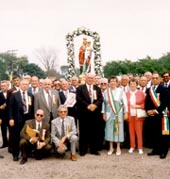 Capurso natives in Chicago, USA.
Capurso natives in Chicago, USA.
 Madonna of the Well feast in Capurso.
Madonna of the Well feast in Capurso.
|
|
 |
|


 |
|
 |
|
 References
References |
|
 |
|
| [1]. |
Francesco Porcelli, Parliamo di Capurso, A cura del complesso edilizio Borgo S. Michele Arcangelo. |
| [2]. |
Gino Pastore, Racconti Popolari, Tra verità e Invenzioni, Levanti Editori, Bari, 2000. |
| [3]. |
Michele Mariella, La Storia della Madonna del Pozzo, Edizioni LMP, Capurso, 1996. |
|
|
 |
|


 |
|
 |
|

|
|
 |
|
|
|
|



